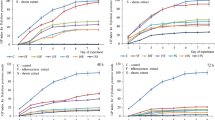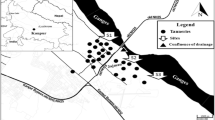Abstract
Key message
We found mistletoe accumulates nutrient elements in its structure as a trap and causes a severe drought stress in the Scots pine in dry summer seasons.
Abstract
The mistletoe [Viscum album ssp. austriacum (Wiesbaur) Vollm.] is a hemiparasitic plant, and its infestation is known to play an important role on the mortality of Scots pines (Pinus sylvestris L.), but there is little knowledge about its action mechanism. This study, therefore, tried to gain a better understanding of the destructive effect of the mistletoe on the growth and water uptake mechanism of the Scots pine. Identical needles from neighboring plants (healthy and infested) were harvested in the middle of each month (from April to October 2013) and used as research material. Infestation success of the mistletoe was investigated by evaluating the contents of the endogenous nutrient elements such as potassium, phosphorus, calcium, sulfur, magnesium, iron, copper, zinc, manganese, boron, nickel, and sodium in both mistletoe leaves and the needles of healthy and infested Scots pine. Its effects were also evaluated by determining the content of water, chlorophyll, and dry matter, and the length of the newly formed needles of the healthy and infested trees. Mistletoe infestation led to a decrease in the availability of water and mineral nutrients, and caused a powerful inhibition on the growth parameters such as chlorophyll, dry matter, and the length of needles by accumulating the essential nutrient minerals in its structure. The findings of this study indicate that the mistletoe accumulates the nutrient elements in its structure as a trap and causes a severe drought stress in the Scots pine in dry summer seasons, thereby playing a potent role in the increasing mortality rate in the Scots pine.








Similar content being viewed by others
References
Ache P, Bauer H, Kollist H, Al-Rasheid KAS, Lautner S, Hartung W, Hedrich R (2010) Stomatal action directly feeds back on leaf turgor: new insights into the regulation of the plant water status from non-invasive pressure probe measurements. Plant J 62:1072–1082
Allen CD, Macalady A, Chenchouni H, Bachelet D, McDowell N, Vennetier M, Gonzales P, Hogg T, Rigling A, Breshears D et al (2010) A global overview of drought and heat-induced tree mortality reveals emerging climate change risks for forests. Forest Ecol Manag 259:660–684
Baquedano FJ, Castillo FJ (2006) Comparative ecophysiological effects of drought on seedlings of the Mediterranean water-saver Pinus halepensis and water-spenders Quercus coccifera and Quercus ilex. Trees Struct Funct 20:689–700
Bell T, Adams M (2011) Attack on all fronts: functional relationships between aerial and root parasitic plants and their woody hosts and consequences for ecosystems. Tree Physiol 31:3–15
Bigler C, Braker OU, Bugmann H, Dobbertin M, Rigling A (2006) Drought as an inciting mortality factor in Scots pine stands of the Valais, Switzerland. Ecosystems 9:330–343
Bolin J, Tennacoon K, Maass E (2010) Mineral nutrition and heterotrophy in the water conservative holoparasite Hydnora Thunb. Flora 205:802–810
Brodribb TJ, Holbrook NM (2003) Stomatal closure during leaf dehydration, correlation with other leaf physiological traits. Plant Physiol 132:2166–2173
Brodribb TJ, Holbrook NM, Edwards EJ, Gutierrez MV (2003) Relations between stomatal closure, leaf turgor and xylem vulnerability in eight tropical dry forest trees. Plant Cell Environ 26:443–450
Buckley TN, Mott KA, Farquhar GD (2003) A hydromechanical and biochemical model of stomatal conductance. Plant Cell Environ 26:1767–1785
Catal Y, Carus S (2011) Effect of pine mistletoe on radial growth of Crimean pine (Pinus nigra) in Turkey. J Environ Biol 32:263–270
Cech TL, Perny B (2000) Kiefernsterben in Tirol. Forstschutz Aktuell Wien 22:12–15
Dobbertin M, Rigling A (2006) Pine mistletoe (Viscum album ssp. austriacum) contributes to Scots pine (Pinus sylvestris) mortality in the Rhone valley of Switzerland. For Pathol 36:309–322
Dobbertin M, Hilker N, Rebetez M, Zimmermann NE, Wohlgemoth T, Rigling A (2005) The upward shift in altitude of pine mistletoe (Viscum album ssp. austriacum) in Switzerland the result of climate warming? Int J Biometeorol 50:40–47
Eilmann B, Weber P, Rigling A, Eckstein D (2006) Growth reactions of Pinus sylvestris L. and Quercus pubescens Willd. to drought years at a xeric site in Valais, Switzerland. Dendrochronologia 23:121–132
Erbilgin N, Raffa KF (2002) Association of declining red pine stands with reduced populations of bark beetle predators, seasonal increases in root colonizing insects, and incidence of root pathogens. For Ecol Manag 164:221–236
Escher P, Peuke AD, Bannister P, Fink S, Hartung W, Jiang F, Rennenberg H (2008) Transpiration, CO2 assimilation, WUE, and stomatal aperture in leaves of Viscum album (L.): effect of abscisic acid (ABA) in the xylem sap of its host (Populus euamericana). Plant Physiol Biochem 46:64–70
Ewers BE, Mackay DS, Samanta S (2007) Interannual consistency in canopy stomatal conductance control of leaf water potential across seven tree species. Tree Physiol 27:11–24
Flexas J, Medrano H (2002) Energy dissipation in C3 plants under drought. Funct Plant Biol 29:1209–1215
Gao D, Gao Q, Xu H-Y, Ma F, Zhao C-M, Liu J-Q (2009) Physiological responses to gradual drought stress in the diploid hybrid Pinus densata and its two parental species. Trees Struct Funct 23:717–728
Giuggiola A, Bugmann H, Zingg A, Dobbertin M, Rigling A (2013) Reduction of stand density increases drought resistance in xeric Scots pine forests. For Eco. Manag 310:827–835
Glatzel G (1983) Mineral nutrition and water relations of hemiparasitic mistletoes: a question of partitioning. Experiments with Loranthus europaeus on Quercus petrea and Quercus robur. Oecologia 56:193–201
Glatzel G (1996) Ecophysiology of Amyema mackayense, a mistletoe on a salt excreting mangrove host. Adv Parasit Plant Res 36:293–302
Glatzel G, Geils BW (2009) Mistletoe ecophysiology: host-parasite interactions. Botany 87:10–15
Gullo MAL, Glatzel G, Devkota M, Raimondo F, Trifilo P, Richter H (2012) Mistletoes and mutant albino shoots on woody plants as mineral nutrient traps. Ann Bot Lond 109:1101–1109
Hibberd JM, Jeschke WD (2001) Solute flux into parasitic plants. J Exp Bot 52:2043–2049
Hosseini SM, Kartoolinejad D, Mirnia SK, Tabibzadeh Z, Akbarinia M, Shayanmehr F (2007) The effects of Viscum Album L. on foliar weight and nutrients content of host trees in Caspian forests (Iran). Pol J Ecol 55:579–583
Karunaichamy K, Paliwal K, Arp P (1999) Biomass and nutrient dynamics of mistletoe (Dendrophthoe falcata) and neem (Azadirachta indica) seedlings. Curr Sci Bangalore 76:840–843
Kaya C, Ashraf M, Sonmez O (2015) Promotive effect of exogenously applied thiourea on key physiological parameters and oxidative defense mechanism in salt-stressed Zea mays L. plants. Turk J Bot 39:786–795
Kuijt J (1977) Haustoria of phanerogamic parasites. Ann Rev Phytopathol 15:91–118
Kuijt J, Toth R (1976) Ultrastructure of angiosperm haustoria-a review. Ann Bot Lond 40:1121–1130
Lamont B, Southall K (1982) Distribution of mineral nutrients between the mistletoe Amyema preissii, and its host, Acacia acuminata. Ann Bot Lond 49:721–725
Lichtenthaler HK, Buschmann C (2001) Chlorophylls and carotenoids: measurement and characterization by UV-VIS spectroscopy. In: Wrolstad RE (Ed.), Current protocols in food analytical chemistry. John Wiley and Sons, New York, pp F4.3.1–F4.3.8
Lüttge U, Haridasan M, Fernandes GW, de Mattos EA, Trimborn P, Franco AC, Caldas LS, Ziegler H (1998) Photosynthesis in mistletoes in relation to their hosts at various sites in tropical Brazil. Trees Struct Funct 12:167–174
Mathiasen RL, Nickrent DL, Shaw DC, Watson DM (2008) Mistletoes: pathology, systematics, ecology, and management. Plant Dis 92:988–1006
Mutlu S, Atici O, Esim N (2010) Bioherbicidal effects of essential oils of Nepeta meyeri Benth. on weed spp. Allelopath J 26:291–300
Mutlu S, Atici O, Esim N, Mete E (2011) Essential oils of catmint (Nepeta meyeri Benth.) induce oxidative stress in early seedlings of various weed species. Acta Physiol Plant 33:943–951
Mutlu S, Atici O, Gulen Y (2013) Cement dust pollution induces toxicity or deficiency of some essential elements in wild plants growing around a cement factory. Toxicol Ind Health 29:474–480
Olson AR, Kuijt J (1985) Sieve elements in the morphologically reduced mistletoe, Viscum minimum Harvey (Viscaceae). Am J Bot 72:1220–1224
Osma E, Ilhan V, Yalcin IE (2014) Heavy metals accumulation causes toxicological effects in aquatic Typha domingensis Pers. Braz J Bot 37:461–467
Press M, Smith S, Stewart G (1991) Carbon acquisition and assimilation in parasitic plants. Func Ecol 5:278–283
Reblin JS, Logan BA (2015) Impacts of eastern dwarf mistletoe on the stem hydraulics of red spruce and white spruce, two host species with different drought tolerances and responses to infection. Trees Struct Funct 29:475–486
Reid N, Yan ZG, Fittler J (1994) Impact of mistletoes (Amyema miquelii) on host (Eucalyptus blakelyi and Eucalyptus melliodora) survival and growth in temperate Australia. For Ecol Manag 70:55–65
Reid RJ, Hayes JE, Post A, Stangoulis JCR, Graham RD (2004) A critical analysis of the causes of boron toxicity in plants. Plant Cell Environ 25:1405–1414
Rigling A, Eilmann B, Koechli R, Dobbertin M (2010) Mistletoe-induced crown degradation in Scots pine in a xeric environment. Tree Physiol 30:845–852
Sangüesa-Barreda G, Linares JC, Camarero JJ (2012) Mistletoe effects on Scots pine decline following drought events: insights from within-tree spatial patterns, growth and carbohydrates. Tree Physiol 32:585–598
Sangüesa-Barreda G, Linares JC, Camarero JJ (2013) Drought and mistletoe reduce growth and water-use efficiency of Scots pine. For Ecol Manag 296:64–73
Shi GR, Cai QS (2009) Photosynthetic and anatomic responses of peanut leaves to zinc stress. Biol Plantarum 53:391–394
Strong GL, Bannister P, Burritt D (2000) Are mistletoes shade plants? CO2 assimilation and chlorophyll fluorescence of temperate mistletoes and their hosts. Ann Bot Lond 85:511–519
Taiz L, Zeiger E (2010) Plant physiology, 5th edn. Sinauer Associates Inc, Suderland
Tennakoon KU, Pate JS (1996) Effects of parasitism by a mistletoe on the structure and functioning of branches of its host. Plant Cell Environ 19:517–528
Thabeet A, Vennetier M, Gadbin-Henry C, Denelle N, Roux M, Caraglio Y, Vila B (2009) Response of Pinus sylvestris L. to recent climatic events in the French Mediterranean region. Trees Struct Funct 23:843–853
Tsopelas P, Angelopoulos A, Economou A, Soulioti N (2004) Mistletoe (Viscum album) in the fir forest of Mount Parnis, Greece. For Ecol Manag 202:59–65
Ture C, Bocuk H, Asan Z (2010) Nutritional relationships between hemi-parasitic mistletoe and some of its deciduous hosts in different habitats. Biologia 65:859–867
Vacchiano G, Garbarino M, Mondino EB, Motta R (2012) Evidences of drought stress as a predisposing factor to Scots pine decline in Valle d’Aosta (Italy). Eur J For Res 131:989–1000
Weber P, Bugmann H, Fonti P, Rigling A (2008) Using a retrospective dynamic competition index to reconstruct forest succession. For Ecol Manag 254:96–106
Willmott CJ, Rowe CM, Mintz Y (1985) Climatology of the terrestrial seasonal water cycle. Int J Climatol 5:589–606
Ziegler H, Weber J, Lüttge UE (2009) Thermal dissipation probe measurements of sap flow in the xylem of trees documenting dynamic relations to variable transpiration given by instantaneous weather changes and the activities of a mistletoe xylem parasite. Trees Struct Funct 23:441–450
Zuber D (2004) Biological flora of central Europe: Viscum album L. Flora 199:188–203
Zweifel R, Steppe K, Sterck FJ (2007) Stomatal regulation by microclimate and tree water relations: interpreting ecophysiological field data with a hydraulic plant model. J Exp Bot 58:2113–2131
Zweifel R, Bangerter S, Rigling A, Sterck FJ (2012) Pine and mistletoes: how to live with a leak in the water flow and storage system? J Exp Bot 63:2565–2578
Acknowledgments
We are grateful to Erzincan University for appropriating research funds (Project No: 12.02.05) and to the Turkish State Meteorological Service (TSMS) for providing meteorological data.
Author information
Authors and Affiliations
Corresponding author
Ethics declarations
Conflict of interest
The authors declare that they have no conflict of interest.
Additional information
Communicated by U. Luettge.
Rights and permissions
About this article
Cite this article
Mutlu, S., Osma, E., Ilhan, V. et al. Mistletoe (Viscum album) reduces the growth of the Scots pine by accumulating essential nutrient elements in its structure as a trap. Trees 30, 815–824 (2016). https://doi.org/10.1007/s00468-015-1323-z
Received:
Revised:
Accepted:
Published:
Issue Date:
DOI: https://doi.org/10.1007/s00468-015-1323-z




